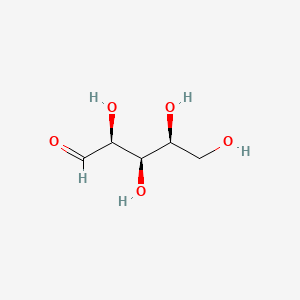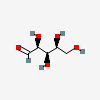L-Xylose
- L-xylose
- 609-06-3
- L-(-)-XYLOSE
- (2S,3R,4S)-2,3,4,5-tetrahydroxypentanal
- aldehydo-L-xylose
- Create:2004-09-16
- Modify:2025-01-11



- L-xylose
- 609-06-3
- L-(-)-XYLOSE
- (2S,3R,4S)-2,3,4,5-tetrahydroxypentanal
- aldehydo-L-xylose
- L(+)-Xylose
- Xylose, L-
- L-xylo-pentose
- A4JW0V2MYA
- MFCD00151096
- L-Xyl
- EINECS 210-174-1
- UNII-A4JW0V2MYA
- NSC 26213
- CHEBI:17979
- DTXSID50883340
- NSC-26213
- L(-)-Xylose
- L-(+)-xylose
- SCHEMBL59766
- GTPL4720
- CHEBI:65328
- DTXCID301022878
- 25990-60-7
- GEO-02456
- s5830
- AKOS024437975
- CS-W009191
- AC-30677
- HY-78139
- X0021
- H10761
- Q27082478
- 52E637A7-1509-4D9B-BF82-19C9C5A6B38B
 D-Xylose (annotation moved to)
D-Xylose (annotation moved to)
H315 (28.6%): Causes skin irritation [Warning Skin corrosion/irritation]
H319 (28.6%): Causes serious eye irritation [Warning Serious eye damage/eye irritation]
H335 (28.6%): May cause respiratory irritation [Warning Specific target organ toxicity, single exposure; Respiratory tract irritation]
P261, P264, P264+P265, P271, P280, P302+P352, P304+P340, P305+P351+P338, P319, P321, P332+P317, P337+P317, P362+P364, P403+P233, P405, and P501
(The corresponding statement to each P-code can be found at the GHS Classification page.)
Aggregated GHS information provided per 7 reports by companies from 3 notifications to the ECHA C&L Inventory. Each notification may be associated with multiple companies.
Reported as not meeting GHS hazard criteria per 5 of 7 reports by companies. For more detailed information, please visit ECHA C&L website.
There are 2 notifications provided by 2 of 7 reports by companies with hazard statement code(s).
Information may vary between notifications depending on impurities, additives, and other factors. The percentage value in parenthesis indicates the notified classification ratio from companies that provide hazard codes. Only hazard codes with percentage values above 10% are shown.
Skin Irrit. 2 (28.6%)
Eye Irrit. 2A (28.6%)
STOT SE 3 (28.6%)
Patents are available for this chemical structure:
https://patentscope.wipo.int/search/en/result.jsf?inchikey=PYMYPHUHKUWMLA-WISUUJSJSA-N
- CAS Common ChemistryLICENSEThe data from CAS Common Chemistry is provided under a CC-BY-NC 4.0 license, unless otherwise stated.https://creativecommons.org/licenses/by-nc/4.0/
- ChemIDplusChemIDplus Chemical Information Classificationhttps://pubchem.ncbi.nlm.nih.gov/source/ChemIDplus
- EPA Chemicals under the TSCAEPA TSCA Classificationhttps://www.epa.gov/tsca-inventory
- EPA DSSToxCompTox Chemicals Dashboard Chemical Listshttps://comptox.epa.gov/dashboard/chemical-lists/
- European Chemicals Agency (ECHA)LICENSEUse of the information, documents and data from the ECHA website is subject to the terms and conditions of this Legal Notice, and subject to other binding limitations provided for under applicable law, the information, documents and data made available on the ECHA website may be reproduced, distributed and/or used, totally or in part, for non-commercial purposes provided that ECHA is acknowledged as the source: "Source: European Chemicals Agency, http://echa.europa.eu/". Such acknowledgement must be included in each copy of the material. ECHA permits and encourages organisations and individuals to create links to the ECHA website under the following cumulative conditions: Links can only be made to webpages that provide a link to the Legal Notice page.https://echa.europa.eu/web/guest/legal-noticeL-(-)-xylose (EC: 210-174-1)https://echa.europa.eu/information-on-chemicals/cl-inventory-database/-/discli/details/64042
- FDA Global Substance Registration System (GSRS)LICENSEUnless otherwise noted, the contents of the FDA website (www.fda.gov), both text and graphics, are not copyrighted. They are in the public domain and may be republished, reprinted and otherwise used freely by anyone without the need to obtain permission from FDA. Credit to the U.S. Food and Drug Administration as the source is appreciated but not required.https://www.fda.gov/about-fda/about-website/website-policies#linking
- New Zealand Environmental Protection Authority (EPA)LICENSEThis work is licensed under the Creative Commons Attribution-ShareAlike 4.0 International licence.https://www.epa.govt.nz/about-this-site/general-copyright-statement/
- ChEBIAldehydo-L-xylosehttps://www.ebi.ac.uk/chebi/searchId.do?chebiId=CHEBI:17979
- Yeast Metabolome Database (YMDB)aldehydo-L-Xylosehttps://www.ymdb.ca/compounds/YMDB00821
- GlyTouCan Project
- Japan Chemical Substance Dictionary (Nikkaji)
- Metabolomics Workbench
- Rhea - Annotated Reactions DatabaseLICENSERhea has chosen to apply the Creative Commons Attribution License (http://creativecommons.org/licenses/by/4.0/). This means that you are free to copy, distribute, display and make commercial use of the database in all legislations, provided you credit (cite) Rhea.https://www.rhea-db.org/help/license-disclaimer
- Springer Nature
- Thieme ChemistryLICENSEThe Thieme Chemistry contribution within PubChem is provided under a CC-BY-NC-ND 4.0 license, unless otherwise stated.https://creativecommons.org/licenses/by-nc-nd/4.0/
- Wikidataaldehydo-L-xylosehttps://www.wikidata.org/wiki/Q27082478
- PubChem
- GHS Classification (UNECE)GHS Classification Treehttp://www.unece.org/trans/danger/publi/ghs/ghs_welcome_e.html
- EPA Substance Registry ServicesEPA SRS List Classificationhttps://sor.epa.gov/sor_internet/registry/substreg/LandingPage.do
- Glycan Naming and Subsumption Ontology (GNOme)GNOme
- MolGenieMolGenie Organic Chemistry Ontologyhttps://github.com/MolGenie/ontology/
- PATENTSCOPE (WIPO)SID 403440209https://pubchem.ncbi.nlm.nih.gov/substance/403440209

